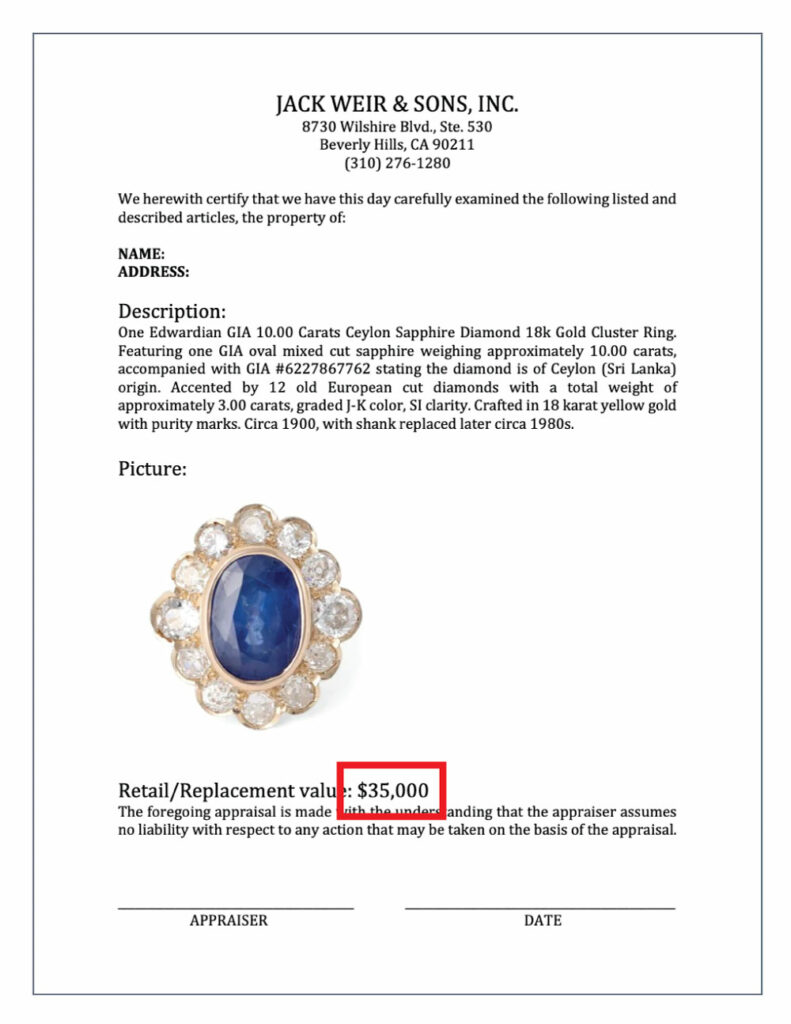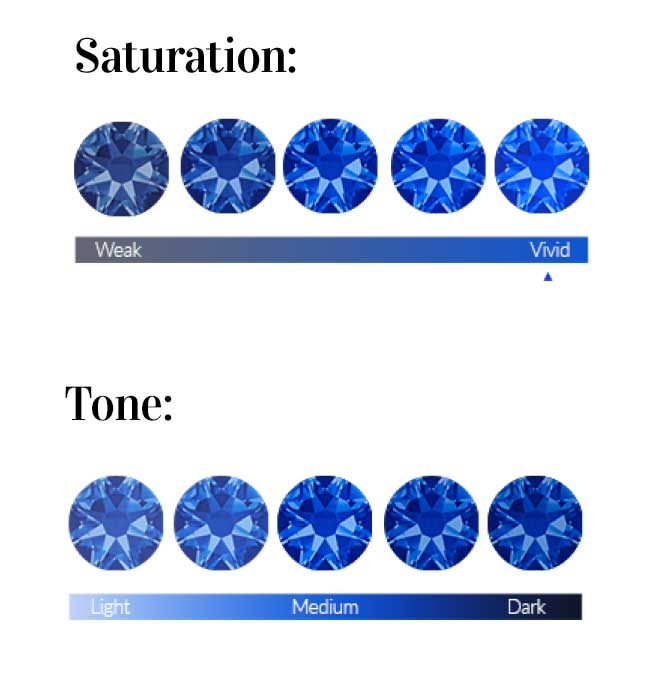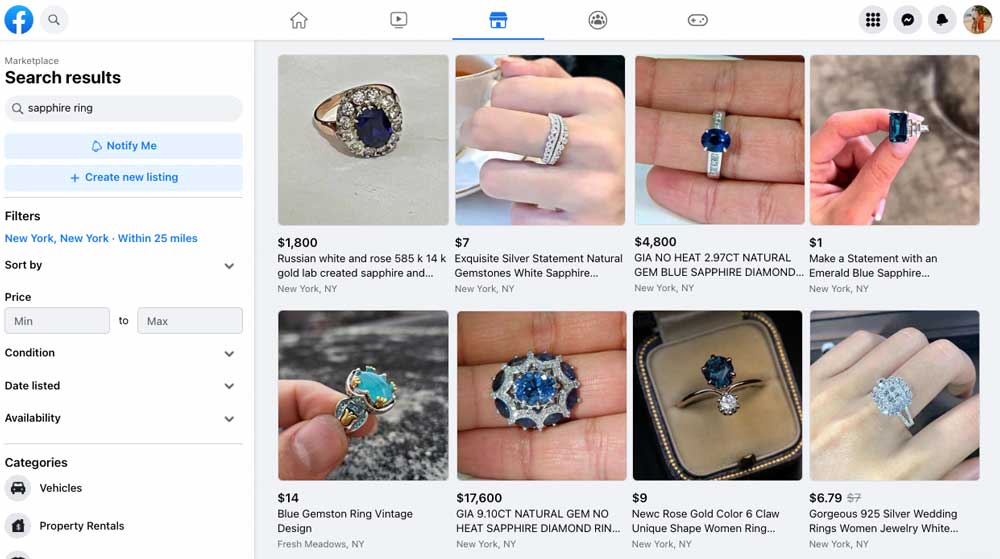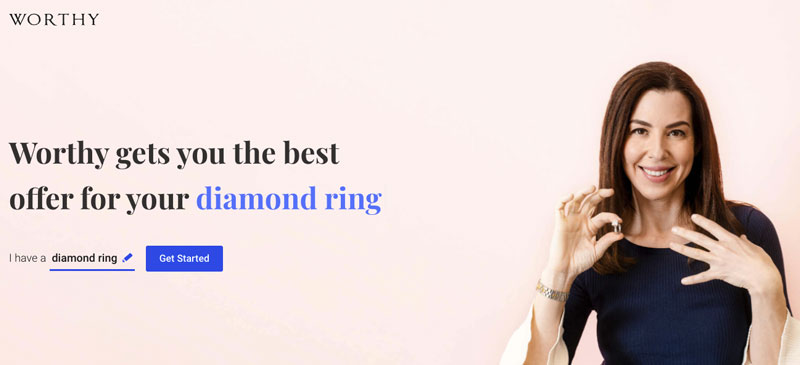Sapphire Value: Understand How to Get The Most When Selling Sapphire Jewelry
Plus: The Guide to Sapphire Buyers and Where To Sell

By Alastair Smith · Updated: June 13th 2023
If you’re lucky enough to own a sapphire, you know there’s something captivating about its vibrant hues, whether that’s the iconic deep blue or one of the less traditional colors like pink, yellow, or even white.
But how much is your sapphire truly worth?
That’s the question we’ll help you answer in this article.

Ringspo is reader supported
Ringspo is reader-supported, which means we may receive a commission if you click a link to a retailer & subsequently make a purchase.
We feature links to several retailers to help readers find the one that is the best fit for them. Find out more about how Ringspo works here.
Three things to know if you are looking to sell your sapphire jewelry
- Selling a sapphire is like selling a second-hand car – you won’t get the ‘list price’ ie. the appraisal value
- The color if the most important in deciding the value of your stone – everything else is secondary, including carat weight
- Finding the right buyer is key to get the most money possible. We recommend Worthy as they will get your sapphire jewelry out in front of as many potential buyers as possible, which can increase you sale price.
Why Your Receipt or Appraisal Isn’t the Best Indicator of What Your Sapphire is Actually Worth:
First-off, we’re going to get this slightly awkward bit out of the way.
While you may have the original purchase receipt or an appraisal for your sapphire jewelry that has a price or a valuation on it, they almost certainly don’t reflect the current market value of your sapphire if you were trying to sell it.

The reason for this is that anyone who is going to buy your sapphire will be looking to sell it for a price that is appropriate for a pre-owned piece of jewelry. Plus, they need to cover their own costs and build in some profit margin for themselves.
What appraisals or a receipt are useful for:
Both a purchase receipt and an appraisal should contain essential information about your sapphire such as its carat weight, color, clarity, cut, origin, and any treatments it has undergone.
They should also detail the type and quality of the metal and any other gemstones included in the jewelry.
This is all essential information that you’ll need when selling your sapphire as it will allow potential buyers to understand what you have..
Factors That Affect Sapphire Value
When we talk about the value of a sapphire, we’re really talking about how much someone would be willing to pay for it.
For instance, a 1-carat sapphire can cost anywhere from $100 to over $10,000, depending on its quality.

When appraising a sapphire, either brand-new or pre-owned, the key factors that are considered are the “Four Cs”: Color, Clarity, Cut, and Carat weight.
How Sapphire Color affects value
By a significant margin, color is the factor that has the most profound impact on a sapphire’s value.
When we talk about color, we’re actually referring to three separate aspects: hue, saturation, and tone.
- Hue is the basic color of the sapphire. Although we traditionally think of sapphires as blue, they can also be pink, yellow, papradascha and a host of other colors.
- Saturation refers to the intensity or purity of the color. A sapphire with high saturation will display a rich, vivid color, while a sapphire with low saturation might appear dull or washed out.
- Tone is the lightness or darkness of the color, ranging from light to dark.

Saturation and tone can be applied to any of the many hues that sapphires can be found in:

Blue Sapphires
These are the most sought-after sapphires, , with the most desirable blue sapphires exhibit a pure blue hue, a medium tone balancing not being too dark or too light, and a vivid saturation that radiates color intensity.
Hue varies from greenish-blue to violetish-blue, and the value tends to increase as the stone leans more towards a pure blue.
The origin of blue sapphires can also significantly impact their value, with sapphires from Kashmir, Burma (Myanmar), and Ceylon (Sri Lanka) often commanding higher prices.
Pink Sapphires:
The second most popular sapphire color, the ideal pink sapphire boasts a pure pink hue, medium tone, and vivid saturation, much like their blue counterparts.
The pink hue can range from orangy-pink to purplish-pink. The origins of pink sapphires also matter, with stones from Madagascar, Sri Lanka, and Burma (Myanmar) being the most sought-after.
Yellow Sapphires:
With a hue spectrum ranging from greenish-yellow to orangy-yellow, the most valuable yellow sapphires possess a pure yellow hue, medium tone, and strong saturation.
Yellow sapphires from Sri Lanka and Thailand often fetch higher prices due to their attractive color and clarity.
Padparadscha Sapphires
The true stars of the sapphire family are arguably the rare Padparadscha sapphires.
Named after the Sinhalese word for ‘lotus flower,’ these stones showcase a mesmerizing blend of pink and orange.
The most desirable Padparadscha sapphires display a well-balanced mix of these hues, with a medium tone and vivid saturation.
The most valuable sapphires possess a strong, vibrant color that isn’t too light or dark.
Sapphire Clarity:
Sapphire clarity also makes a significant different to their value, with the relative absence of inclusions or blemishes being highly prized.
Clarity in sapphires is assessed using a range of methods, with some of the most common being the eye grade, loupe grade, transparency, and type.
Eye grade is the clarity evaluation of a sapphire under the naked eye, while the loupe grade is a more in-depth look at the gem’s clarity under 10x magnification. These scales examine the presence, size, and position of inclusions and how much they might disrupt the overall appearance and brilliance of the gem.
Transparency is another essential element in clarity grading, as it gauges a sapphire’s ability to transmit light. High transparency can intensify color and brilliance, enhancing the gem’s overall appeal.
Sapphires are classified into types based on their typical level of inclusions:
- Type 1: Sapphires typically eye-clean, meaning inclusions aren’t visible to the naked eye.
- Type 2: Sapphires often have some visible inclusions, but not enough to disrupt their beauty or durability.
- Type 3: Sapphires typically possess numerous visible inclusions, which can affect their appearance and durability.
Sapphires can exhibit a range of inclusions like:
- Crystals: Small internal mineral deposits.
- Needles: Thin, rod-like inclusions that can sometimes create a star effect.
- Feathers: Inclusions resembling fractures or feathers.
- Fingerprints: Inclusions filled with fluid.
- -ilk: Fine, needle-like inclusions that can impart a silky sheen.
- Color Zoning: Uneven color distribution due to varying growth conditions.
It’s important to not though that inclusions aren’t always undesirable. Certain inclusions can actually enhance a sapphire’s beauty or value. This includes the phenomena of asterism, chatoyancy, and color change:
- Asterism (or star effect) is a six-rayed star pattern on the gemstone’s surface under specific light conditions, commonly found in blue and black star sapphires.
- Chatoyancy (or cat’s eye effect) is a bright, narrow band of light on the gemstone’s surface, typically observed in yellow and green sapphires.
- Color change sapphires shift their hue based on the lighting conditions, creating an enchanting display of colors.
While clarity is crucial, remember that the value of a gem is a combination of all its qualities. And sometimes, those internal “flaws” can bring about extraordinary beauty, making each sapphire unique and prized.
Cut and its effect on Sapphire Price
The cut of a sapphire refers to how the raw gemstone has been into a final gem, ready to be set into jewelry. While the cut doesn’t alter the color or clarity of the gemstone, it plays a crucial role in unleashing the full brilliance of a sapphire and defining its final shape. Unlike round diamonds, there is no recognised standard from GIA or any other grading authority for what constitutes a well-cut sapphire.
The quality of a sapphire’s cut is evaluated based on several criteria:
- Proportions: This term refers to the relative dimensions of the sapphire, such as its length, width, depth, and table size. The proportions can greatly affect how light interacts with the gemstone, influencing its sparkle and brilliance.
- Symmetry: The balance and alignment of the sapphire’s facets and outline come under this category. High symmetry contributes to the uniform distribution of light throughout the gemstone, thereby maximizing its aesthetic appeal.
- Polish: This relates to the smoothness and quality of the sapphire’s surface. A well-polished sapphire will have minimal blemishes on its surface, enhancing its luster.
Different cuts cater to different aesthetics and can be better suited to different colors and shapes of sapphires

- Round: A timeless classic, the round cut enhances the brilliance and fire of a sapphire, making it a popular choice for all colors.
- Oval: This versatile cut can make a sapphire look larger and showcase its color beautifully, making it ideal for deeply colored sapphires.
- Cushion: With its rounded corners and large facets, the cushion cut lends a romantic, vintage feel to sapphires, particularly those with softer colors.
- Pear: The pear cut, resembling a teardrop, gives a feminine touch to sapphires and is well-suited for use in pendant jewelry.
- Emerald: A sophisticated cut featuring rectangular facets and a large table, the emerald cut lends a refined look to transparent, high-clarity sapphires.
- Marquise: A dramatic and elongated cut that resembles an eye or a boat, the marquise cut can make a sapphire appear larger and is suited for deeply colored gems.
- Princess: A modern, geometric cut, the princess cut adds a contemporary flair to sapphires and works well for transparent, high-clarity gems.
- Heart: An ideal cut for romantic or sentimental pieces, the heart cut showcases the skill of the cutter and adds a whimsical charm to sapphires of all colors.
A well-executed cut with great proportions can add considerable extra value to a sapphire.
Carat: Measuring the Size and Value of Sapphires
In gemology, carat is a standard unit of weight used to measure gemstones and pearls, including sapphires. One carat is equivalent to 0.2 grams or 200 milligrams. Not to be confused with “karat,” a unit used to measure the purity of gold, the term “carat” comes from the carob seeds that were historically used to balance scales in oriental bazaars.
Despite being a unit of weight, carat is often associated with the size of a gemstone. However, it’s important to remember that the size of a sapphire doesn’t correlate directly with its carat weight because different shapes and cuts have varying densities and proportions. The physical size of a sapphire can be better gauged by its dimensions—length, width, and depth—or its diameter for round shapes.
Carat weight plays a significant role in determining the value of a sapphire. Generally, as the carat weight of a sapphire increases, so does its price per carat. This is due to the rarity of larger gemstones—finding a large sapphire with exceptional color, clarity, and cut is a rare feat, thus driving up its price significantly.
However, carat isn’t the only factor affecting a sapphire’s price. The gem’s quality (color, clarity, and cut) also significantly impacts its price per carat. A smaller, high-quality sapphire might be more expensive than a larger one of inferior quality. Moreover, the origin of the sapphire can add to its price due to certain regions’ reputations for producing highly prized gemstones.
Here are a few hypothetical examples demonstrating how carat weight can impact the price of sapphires:
- A 1-carat blue sapphire from Sri Lanka with good color, clarity, and cut might cost between $800 to $1,200 per carat. But, a 2-carat blue sapphire from Kashmir, known for its exceptional blue sapphires, with excellent qualities can exceed $11,000 per carat.
- A 0.5-carat pink sapphire from Madagascar with good color, clarity, and cut might be priced between $300 to $500 per carat. Conversely, a 1.5-carat pink sapphire from Burma with excellent color, clarity, and cut could fetch over $3,000 per carat.
- A 0.7-carat yellow sapphire from Thailand with good color, clarity, and cut might be priced between $100 to $200 per carat. A 1.2-carat yellow sapphire from Sri Lanka with excellent color, clarity, and cut could cost over $500 per carat.
Please note these prices are merely indicative and the actual prices can vary significantly based on a multitude of factors.
Sapphire origin and its effect on value
Origin (where the sapphire was mined) is an important factor that can influence the desirability and therefore the value.
Buyers and collectors often associate certain characteristics or reputations with sapphires from specific locations as the geological conditions and mineral compositions at various mining sites directly influence the formation and characteristics of the sapphires mined there.

- Kashmir: Located in the northernmost geographical region of the Indian subcontinent, sapphires from Kashmir are often described as having a ‘velvety’ texture, possess a cornflower blue hue with a slight violet undertone. These gems are greatly prized for their exceptional beauty and scarcity.
- Burma (Myanmar): Known for high-quality blue and pink sapphires, Burmese sapphires are saturated richly and display a vivid color spectrum from royal blue to purplish pink. Their rarity and prestige add to their desirability and value.
- Sri Lanka: A prolific source of sapphires in a wide array of colors and qualities, Sri Lankan sapphires often have a medium tone and a moderate saturation that gives them a vibrant appearance. Sri Lanka is also renowned for some of the rarest sapphire variants like the pinkish-orange ‘padparadscha’, star sapphires, and color change sapphires.
- Madagascar: A relatively newer entrant into the sapphire market, Madagascar has emerged as a leading source of fine-quality blue and pink sapphires. These stones often possess strong saturation and a pure color similar to Kashmir or Burmese sapphires.
- Australia: A significant player in the global sapphire market, Australia is known for large volumes of commercial-quality blue and green sapphires. These stones often have a dark tone and low saturation, giving them a navy or blackish color. Australian sapphires are often heat-treated to improve their color or clarity.
- Montana, USA: An emerging source of attractive blue and green sapphires, Montanan sapphires have a light tone and high saturation, often resulting in a teal or mint color. Montana sapphires are usually untreated or only lightly heated, which maintains their natural beauty.
Where to Sell Sapphires for the Best Price
When you’re selling sapphire jewelry, it can be tempting to go for a quick, easy sale. However, doing do can mean that you receive significantly less than you should.
If you’re in a hurry to sell and simply Google ‘sapphire buyers near me’ and then choose the first on the list, it’s likely that you will receive significantly less for your diamond than you should.

Selling Your Sapphire To A Jeweler
Selling your sapphire to a jeweler can provide access to their knowledge, experience, and trustworthiness. They can offer insights into the market value of your sapphire and guide you through the selling process.
However, it’s important to be aware that jewelers may offer lower prices due to their overhead costs or inventory needs, have limited demand or availability for certain items, offer subjective opinions, or face potential conflicts of interest if they also serve as appraisers.
- Access to knowledgeable professionals
- Trustworthiness and guidance throughout the selling process
- Market insights and expertise
- Lower prices due to jeweler's overhead costs or inventory needs
- May be limited demand for sapphires
- Subjective opinions
- Potential conflicts of interest
Selling A Sapphire on Online Marketplaces (e.g., Facebook Marketplace, Craigslist, eBay):
Online marketplaces such as Facebook Marketplace, Craigslist, and eBay provide platforms for individuals to buy and sell various items, including gemstones like sapphires.
Selling sapphire through these online marketplaces offers certain advantages and considerations specific to each platform.
Looking at the screenshot of sapphire rings on Facebook marketplace, you can see that there rings price from $1 to $17,600:

This is typical of many non-curated marketplaces – high quality merchandise is mixed in with low-priced items.
This means that your sapphire could be lost in amongst lower quality items, and may be less likely to find a buyer.
- Broad Audience - these platforms have millions of users, increasing the chances of finding a potential buyer
- You have the flexibility to set your own price, upload photos, and write descriptions about your sapphire.
- The process of listing an item for sale is typically simple and can be done from the comfort of your home
- Online platforms can attract fraudulent buyers or scams. It's important to be cautious and use secure payment methods.
- Potential buyers may be skeptical about the quality and authenticity of the sapphire as they can't inspect it in person before buying
- Without sufficient understanding of the gemstone market, you might undervalue or overvalue your sapphire, making it harder to sell
- Possibility of security risks or fraud
Selling Sapphire Jewelry Using An Auction House
Auction houses are establishments that facilitate the sale of gemstones and jewelry to the highest bidder in a public or private setting.
Selling your sapphire through an auction house can offer prestige, access to a knowledgeable audience, and the potential for competitive bidding that could drive up the price.

However, it’s crucial to consider factors such as fees or commissions charged by the auction house, appraisal or consignment costs, the unpredictability of results, and potential waiting times or limited opportunities for auctions.
- Prestige and access to a knowledgeable audience.
- Potential for competitive bidding and higher prices.
- Possibility of driving up the price through bidding.
- Fees or commissions charged by the auction house
- Appraisal or consignment costs
- Unpredictability of results
- Waiting times or limited auction opportunities
Selling Your Sapphire Using A Jewelry-specific Online Platform
Online platforms are websites or apps that connect sellers and buyers of gemstones and jewelry. Selling your sapphire through online platforms can offer convenience, speed, and exposure to a large and global market.
These platforms allow you to reach a wide range of potential buyers. However, it’s important to be aware of potential drawbacks such as fees or commissions charged by the platform, shipping or insurance costs, security or fraud risks, and the possibility of facing competition that may impact prices.
- Convenient and accessible platform with global market reach
- Ability to reach a wide range of potential buyers
- Quick and efficient selling process
- Fees of commissions charged by the platform
- Additional costs for shipping and insurance
- Possibility of security risks or fraud
Selling Your Sapphire To A Pawn Shop
Pawn shops are businesses that offer loans or cash in exchange for gemstones and jewelry as collateral.
Selling your sapphire to a pawn shop can provide quickness, simplicity, and discretion. However, it’s important to be mindful of potential downsides such as lower prices offered due to the shop’s profit margin or lack of expertise, high interest rates or fees if you intend to redeem your item later, limited negotiation options, limited selection, or potential legal or ethical concerns.
- Quick and simple selling process
- Discretion in the transaction
- Potentially faster access to cash
- Lower prices due to the pawn shop's profit margin or lack of expertise with sapphires
- High interest rates or fees if you intend to redeem your item
- Limited negotiation options
Summing Up: Our Recommendation on Where to Sell Your Sapphire
In this article, we’ve explored how to determine the value of your sapphire using factors such as the 4Cs (color, clarity, cut, and carat weight), as well as other considerations like origin, treatment, and certification.
We have also discussed various options for selling your sapphire to obtain the best price.
Online platforms, auction houses, pawn shops, jewelers, and private buyers each have their own advantages and considerations. It’s essential to carefully evaluate these options based on your goals, preferences, and situation to make an informed decision.
Worthy.com: The Best Way To Sell A Sapphire For Most People
Worthy is an auction site that gets your sapphire jewelry out in front of hundreds of jewelry buyers to bid on.
This scale means that higher sales prices can be achieved, particularly if you have an item that several people are interested in.
You can learn more about
And again, if you haven’t checked it out, the ‘recent auctions‘ page is definitely worth checking out.

